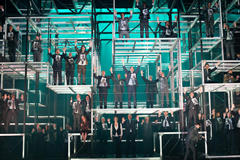| Opera Reviews | 30 April 2024 |
The strange case of Beethoven's Fidelioby Colin Anderson |
|
| Beethoven: Fidelio English National Opera 25 September 2013 |
|
|
Back to Leonore 3, which Mahler and Bernstein conscripted to link the scenes of Act II; Bernstein's way with it at that point (minus the opening chords) - as recorded - was a stroke of genius. And while this symphonic poem-manqué is being played out as an elongated and too long prelude, we see some sort of climbing frame, really a maze, populated by slithery subjects, and including an early appearance of Florestan (a double for Stuart Skelton), throwing himself around, imprisoned. Such shenanigans pall very early on. Calixto Bieito's direction is limited to this design, and something similar in the second Act; it's all rather like a concert performance on a building site. Your reviewer found little illumination or profundity, more an invitation to not take it seriously or to get het up. So I won't. Some green light represents (presumably) the garden that the inmates are allowed into at the end of Act One, but that was curiously unmoving here, although generally the musical side of things is good, or better, not least some very impressive horns in Fidelio/Leonore's 'Abscheulicher!' and the ENO Orchestra as a whole plays with discipline and commitment, Edward Gardner pacing the work well and vividly projecting it, one eye (maybe half) on 'period' niceties or intrusions; depends on your point of view. The singing is fine, if inconsistent, and some of David Pountney's English translation is not an exact fit, or made to seem so. Emma Bell portrays Fidelio/Leonore as principled and determined, Philip Horst does a nice job as the psychopathic prison governor, and Stuart Skelton is heroic, if maybe overloud at times (one hell of a crescendo on his first word, "God"). Roland Wood's dandified Minister looks like a cross between royalty and a town crier (shoots a gun, too). Other characters, singing well mind, may not have been so much on Bieito's agenda (whatever that may be) and so they seem underdeveloped as people and emerge more as ciphers. The lighting is dark (enough to not always work out some of the props), the mood suitably oppressive, and when some brightness arrives at the end of the opera (during which the ENO Chorus sings lustily) one has to close one's eyes against the reflective glare. The dash to the finishing post finds the Orchestra a little muted; maybe deliberately suggesting that nothing has in fact changed. As I understand it, those who have seen The Matrix (which I have not) may find more in this production than that written above. |
|
| Text ©
Colin Anderson Photo © Tristram Kenton |

 After
some prose, we get to the Overture, the 'wrong' one, Leonore No.3, whereas
No.2 has more of a historical precedent (but there is of course the
Fidelio Overture itself, which is not to be heard here). Then, between
the scenes of Act II, arrives a string quartet, the foursome known collectively
as the Heath, coming down from the roof in cages (Stockhausen and helicopters
came to mind). These musicians play beautifully, the music is sublime
- at least it's by Beethoven - some (not all) of the slow movement of
the opus 132 String Quartet. But it's incongruous.
After
some prose, we get to the Overture, the 'wrong' one, Leonore No.3, whereas
No.2 has more of a historical precedent (but there is of course the
Fidelio Overture itself, which is not to be heard here). Then, between
the scenes of Act II, arrives a string quartet, the foursome known collectively
as the Heath, coming down from the roof in cages (Stockhausen and helicopters
came to mind). These musicians play beautifully, the music is sublime
- at least it's by Beethoven - some (not all) of the slow movement of
the opus 132 String Quartet. But it's incongruous. 





